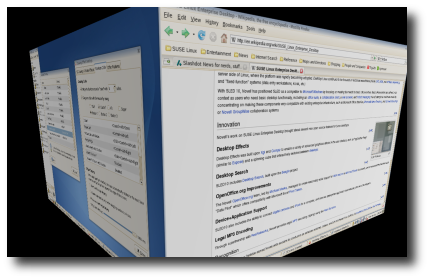
It has been a fairly idle week as far as technology news is concerned (possibly caused by the collapse of the world's financial markets), so we aggregate a variety of topics which we typically cover separately, starting with OpenSUSE.
OpenSUSE 11.1
Kristin Shoemaker, who frequently writes about SUSE, published
this post about the betas of Ubuntu and OpenSUSE.
Today, both Ubuntu and openSUSE are releasing beta versions of their upcoming releases.
Over at
Heise, the release of OpenSUSE's second beta made it in as an article.
OpenSuse's developers have released a second beta of OpenSuse 11.1 after the first beta had problems and could damage Intel e1000e network cards. The problem, which appears to affect all Linux Kernel 2.6.27 releases candidates up to rc8, involved some unknown process overwriting the NVRAM settings of the network chipset which was left writeable by the network driver. The fix has been a patch to the network driver to lock the NVRAM and stop the overwriting. It is this patch which has been incorporated into this second beta and in the Linux Kernel 2.6.27-rc8 release.
A screenshots gallery of this beta
was published early in the week.
I must say I have always loved SUSE for the desktop, but after a month or so I always wind up switching back to Ubuntu or Ubuntu based Distributions. Now OpenSuse always maintains it's beautiful look as always as well as the infamous YAST tool. In the end of this install it failed trying to install GRUB, since this is in Beta I would have to assume this is a bug but none the less OpenSuse is a great OS.
As OpenSUSE 11.1 comes nearer and nearer, OpenSUSE 10.2 is being phased out. Here is a
summary of some updates:
* Advance notice of discontinuation of openSUSE 10.2
* openSUSE-Education 1.0 for 11.0 is Ready
* openSUSE 11.1 Beta 2 Now Available
* Board Election - Phase 1: Nomination of second voters
* openSUSE News: Status of the e1000e Issue
Technical
Waxborg (Vahis) has published a new page about
installation of FreeNX in OpenSUSE. He has been doing this type of stuff for quite a few years. There are some more technical posts in the OpenSUSE Web site. Here is
one about zypper.
I[']m impressed how many users don’t know new zypper features.
There is also the experience of another person who
chose Apple hardware for his OpenSUSE setup.
This is my experience with openSUSE 11.0 on the eMac G4, 1.25Ghz, sporting a Radeon 9200 graphics card. The specs are here. Mine was the lesser of the two modles, with the 40GB drive, but 1GB of RAM.
Organisational
It seems like the end of an era because
Andreas Jaeger retires from the board.
I have served as chairperson of the openSUSE board the last year and would like to announce that I decided to pass the honours on for the next election period. I’ve made this decision out of personal plans for the next year that will not allow me to devote as much time to the board as it deserves since I’ll be some time on paternity leave.
As Zonker
points out in this post, it was Andreas who kicked off the project three years ago.
Just three years ago today, the openSUSE Project announced its first release.
Zonker announces OpenSUSE's presence in
2 Linuxfests that have just ended or still run today.
The openSUSE Project is going to have a presence at the Indiana Linuxfest and Ohio Linuxfests this weekend.
He also published
a good post in ZDNet.
SLED
As mentioned very briefly earlier in the week, Novell is quoted as cheering sub-notebooks. Here is
the article from IDG's John Ribeiro (also appeared
in PC Advisor). It smells like an advert for Novell's SUSE.
The benefit of pre-loaded SUSE Linux for the user is that Novell works with the computer vendor to ensure that all the Linux device drivers are there, and the user has a far better experience than if he were to try to install the operating system on a variety of hardware, Friedman said.
There is already a
rebuttal to this article.
The Industry Standard is running an interesting interview with Novell CTO Nat Friedman about Netbooks. In the process he made some interesting statements that seem to indicate that Novell understands Netbooks…at least the way there were initially.
[...]
In my experience this is half right. Netbooks tend to be used both for net browsing/email and light notebook tasks like note taking and simple office documents. On top of that are some elements of leisure activities, like watching video or reading ebooks. Linux can certainly handle most of those tasks just as well as Windows can, however people still tend to want to be able to install applications the way they are used to on Windows, and use programs they are familiar with, like IE or Outlook.
Xandros
Not much to see here either, but Xandros is reportedly used as the base for testing this
Blackberry-GNU/Linux sync software.
A developer of Mac-based sync utilities is seeking beta testers for what it calls "the first Linux-to-BlackBerry sync solution." Information Appliance Associates (IAA) is initially testing its free "PocketMac for BlackBerry, Linux Edition" software on Xandros Linux running the KDE PIM suite.
Later on we will post the remainder of the news.
⬆


Comments
Andre
2008-10-11 19:50:17
Sebastiaan Veld
2008-10-12 09:31:15
Roy Schestowitz
2008-10-12 10:31:54